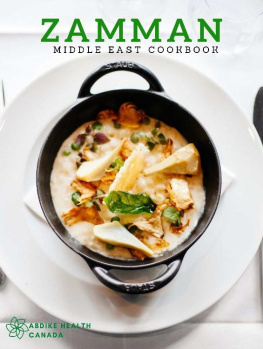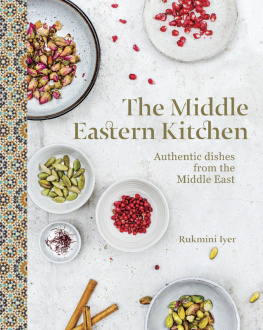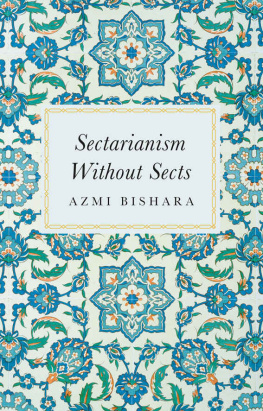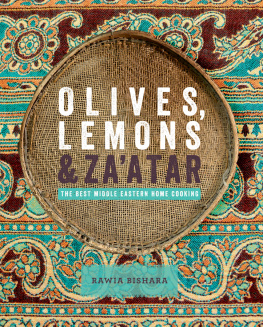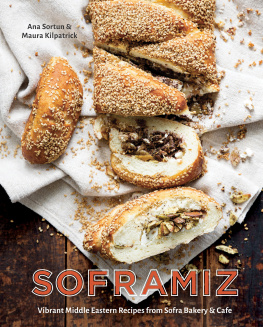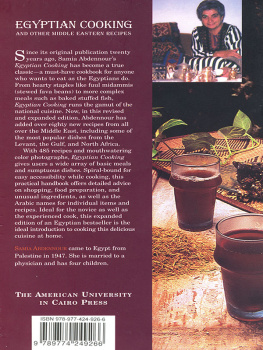Bishara - Olives, Lemons and Zaatar: The Best Middle Eastern Home Cooking
Here you can read online Bishara - Olives, Lemons and Zaatar: The Best Middle Eastern Home Cooking full text of the book (entire story) in english for free. Download pdf and epub, get meaning, cover and reviews about this ebook. year: 2019, publisher: Octopus, genre: Home and family. Description of the work, (preface) as well as reviews are available. Best literature library LitArk.com created for fans of good reading and offers a wide selection of genres:
Romance novel
Science fiction
Adventure
Detective
Science
History
Home and family
Prose
Art
Politics
Computer
Non-fiction
Religion
Business
Children
Humor
Choose a favorite category and find really read worthwhile books. Enjoy immersion in the world of imagination, feel the emotions of the characters or learn something new for yourself, make an fascinating discovery.
- Book:Olives, Lemons and Zaatar: The Best Middle Eastern Home Cooking
- Author:
- Publisher:Octopus
- Genre:
- Year:2019
- Rating:3 / 5
- Favourites:Add to favourites
- Your mark:
- 60
- 1
- 2
- 3
- 4
- 5
Olives, Lemons and Zaatar: The Best Middle Eastern Home Cooking: summary, description and annotation
We offer to read an annotation, description, summary or preface (depends on what the author of the book "Olives, Lemons and Zaatar: The Best Middle Eastern Home Cooking" wrote himself). If you haven't found the necessary information about the book — write in the comments, we will try to find it.
Bishara: author's other books
Who wrote Olives, Lemons and Zaatar: The Best Middle Eastern Home Cooking? Find out the surname, the name of the author of the book and a list of all author's works by series.
Olives, Lemons and Zaatar: The Best Middle Eastern Home Cooking — read online for free the complete book (whole text) full work
Below is the text of the book, divided by pages. System saving the place of the last page read, allows you to conveniently read the book "Olives, Lemons and Zaatar: The Best Middle Eastern Home Cooking" online for free, without having to search again every time where you left off. Put a bookmark, and you can go to the page where you finished reading at any time.
Font size:
Interval:
Bookmark:





Select one of the chapters from the and you will be taken to a list of all the recipes covered in that chapter.
Alternatively, jump to the to browse recipes by ingredient.
Look out for linked text (which is in blue) throughout the ebook that you can select to help you navigate between related recipes.
You can double tap images to increase their size. To return to the original view, just tap the cross in the top left-hand corner of the screen.

Rawia Bishara opened her restaurant Tanoreen in Bay Ridge, Brooklyn in 1998. New York Magazine has named it the best Mezze and #1 Cheap Eats. The New York Times, Gourmet magazine, The New Yorker, The Village Voice, Travel & Leisure, Zagat Restaurant Survey, Michelin Guides, Time Out New York, The New York Post and Food Networks The Best Thing I Ever Ate have all featured or positively reviewed Tanoreen. Rawia has had her recipes published in The New York Times, New York Magazine and Plate Magazine and teaches a recurring class at DeGustibus Culinary School in New York City.
Rawia, in Arabic, means storyteller. But rather than narrate the stories about my family, life and culture, I prefer to tell them through my cooking. In my mind, how ingredients are procured, dishes are served and meals are celebrated speak volumes.
I was born into a food-loving Palestinian-Arab family in Nazareth, a beautiful town in southern Galilee. Though the words organic, locavore and sustainable were unknown then, my parents approach to food and cooking qualified on all counts. They were foodies before the word was coined. And so were their parents before them.
My grandmother always had several ceramic urns filled with fruity olive oil, pressed from the olives my aunts and uncles picked on her familys land. My mother, too, made her own olive oil, and used the remaining crude to make soap. She also distilled her own vinegar, sun-dried herbs and fruits, made batches of goats cheese as well as fermented sweet wine, and jarred jewel-coloured jams from the bounty of the local orchards.
I have endless food memories from my childhood, but the most vivid are the summers I spent with my four brothers and sisters at our grandparents homes in the villages of Rama and Tarshiha in the hills of Galilee. The drive from Nazareth was itself a food lovers dream. A colourful mosaic of rooftops stretched into the horizon, each one laden with vegetables and herbs drying in the sun. There were plum tomatoes, aubergines, okra, smoked wheat, sesame seeds, zaatar, sumac, figs, apricots and spearmint a mouthwatering bounty that would be stored for winter cooking and eating. We returned from our July sojourn with enough food to yield meal after delicious meal for months. This was my childhood; this was how I came to respect where and how food is grown and prepared.
FROM NAZARETH TO NEW YORK
When I married my husband, Wafa, and moved to Bay Ridge in Brooklyn, New York, I found myself immersed in one of the most multicultural regions on earth. I was so enthralled with the diverse cuisines that I practically ate my way through the city. These forays influenced my cooking very dramatically.
I have dozens of fond food memories from my childhood, but the most vivid has long remained the summers I spent with my four brothers and sisters at our grandparents home in Tarshiha in the hills of Galilee.
In the years that followed, my husband and I planned international family trips with our daughter, Jumana, and son, Tarek, which further broadened my culinary repertoire. I will never forget one summer trip to Spain in particular, during which I bribed my children into sharing paella at least once a day, so to experience that national dish in all its variations. That food experience in turn influenced how I prepare my version of sayadiyya, the traditional Middle Eastern fishermans dish.
Our European trips were special, but none quite compared to the visits we regularly took back home to the Middle East. It was important to me that my children not only understood their heritage, but that they connected to Middle Eastern food the way I did as a child.
When my children were grown and on their own, I started to work and became the head of a womens organisation in New York that assisted recent immigrants with their integration into American life. The job involved a lot of entertaining, a role I loved, and my co-workers constantly urged me to open a restaurant, as did friends and family for whom I had been cooking for years. It became clear to me that I needed to take the leap.
CREATING TANOREEN
In 1998, I opened my restaurant, Tanoreen, as a tribute to my mother, Monira Hanna, and to reinterpret her imaginative Middle Eastern cooking. She was an impressive and enthusiastic cook who whipped together meals for the seven us and often many guests who gathered around our table most nights of the week. Though she was inspired by the cooking traditions of her native Galilee, her approach was not rigidly authentic. She understood the value of bending the rules when it came to cooking, a practise we relished at the dinner table. I adored this about her and strive every day to enliven my life and my food with the kind of creative flourishes that defined my mothers life.
Tanoreen is named after a majestic village located in the northern valleys of Lebanon. It is so beautiful that it inspired the iconic Middle Eastern singer, Fairuz, to record an ode to it. The origin of the word is derived from tannour, a stone oven used in ancient times, but, to be honest, I also like that it is easy to pronounce, unlike my name, which I have spent my whole life spelling and pronouncing for people!
Initially I opened Tanoreen in a modest storefront with only twelve tables. The menu featured staples such as simple sandwiches, spreads and salads. However, I quickly established a loyal clientele and learned that what they enjoyed the most was the homestyle cooking closest to my heart. They loved the dishes I had learned to cook from my mother, the meals that have consistently been a source of joy in my life.
An ever-evolving menu combined with happy customers and good word of mouth led to some positive reviews in notable publications. Before I knew it, lines were forming around the block. I needed to expand, and ten years after opening my little restaurant, I made it grow. We bought a property nearby and opened a much larger restaurant, seating 40 to 50 tables, as well as keeping a take-away counter round the back.
EMBRACING CHANGE AND MIXING IT UP
My cooking celebrates tradition and embraces change. In some instances, I recreate dishes as they have been made for generations; other times, I experiment a bit, making a recipe more contemporary by adding a few more spices or offering a few shortcuts. The most popular examples are my Brussels sprouts, prepared with panko and tahini; a lamb shank marinated in herbs and rose buds; a kafta roll (a reconstructed classic); and an aubergine Napoleon made with baba ghanouj layered between crisp aubergine and topped with basil and tomatoes all of which youll find in these pages.
Font size:
Interval:
Bookmark:
Similar books «Olives, Lemons and Zaatar: The Best Middle Eastern Home Cooking»
Look at similar books to Olives, Lemons and Zaatar: The Best Middle Eastern Home Cooking. We have selected literature similar in name and meaning in the hope of providing readers with more options to find new, interesting, not yet read works.
Discussion, reviews of the book Olives, Lemons and Zaatar: The Best Middle Eastern Home Cooking and just readers' own opinions. Leave your comments, write what you think about the work, its meaning or the main characters. Specify what exactly you liked and what you didn't like, and why you think so.


